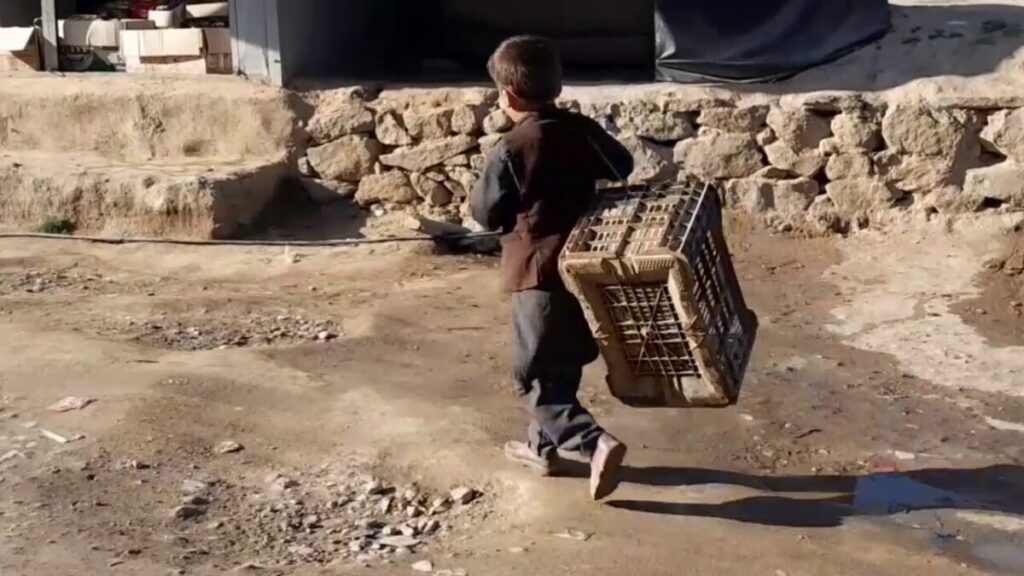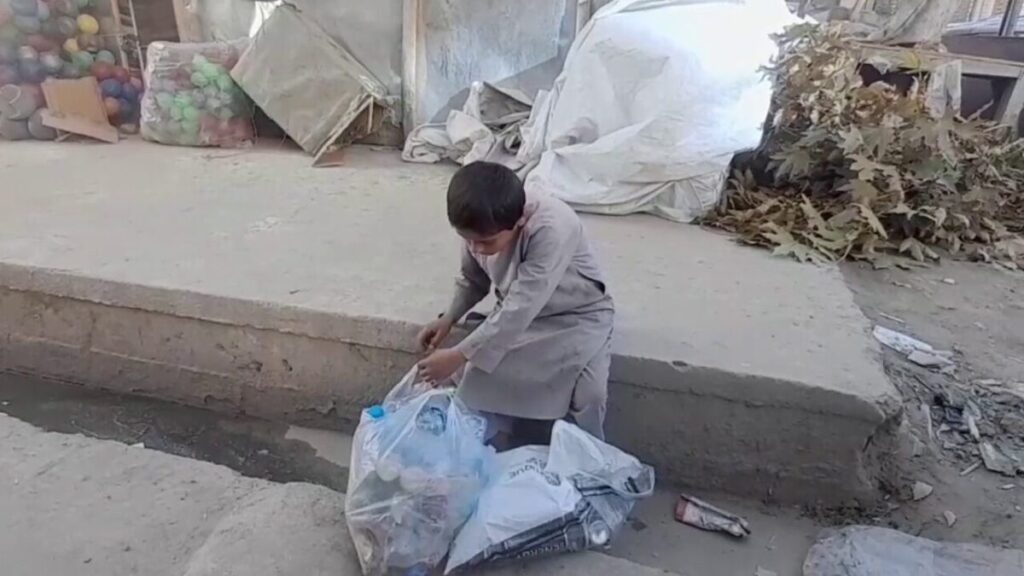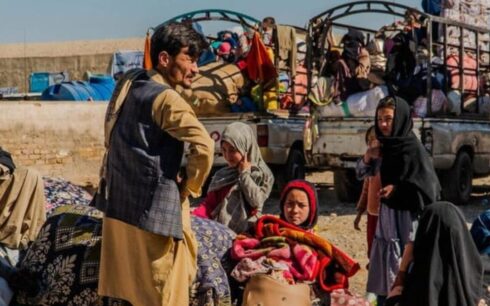A new field study by Amu reveals that “economic hardship” and “family pressure” are the primary drivers of a sharp rise in forced labor across Afghanistan, affecting vulnerable groups, especially children, across the country.
Conducted across eight provinces, the study highlights the limited options for millions of Afghans as they endure challenging and often exploitative work conditions to meet basic family needs.
An alarming 33.3 percent of respondents reported that children are particularly impacted, often bearing the heaviest burdens.
According to a former government official, a 2020 study by Afghanistan’s Ministry of Labor had uncovered that approximately 3 million children were engaged in forced labor before the Taliban takeover. This study, however, was never publicly released due to political sensitivities. Today, researchers estimate that this number has doubled over the past three years, with approximately 6 million children now involved in forced labor, underscoring the severity of the issue.
Amu’s study confirms that entrenched poverty and economic hardship, exacerbated by Afghanistan’s current crisis, remain the root causes of forced labor. For many, family obligations and few alternative opportunities drive them into exploitative situations. The study provides insights into forced labor’s causes and consequences, shedding light on an issue that has deepened amid Afghanistan’s economic collapse.
Key findings: Causes of forced labor in Afghanistan
The study identifies several factors behind the rise in forced labor:
79.1 percent of respondents cited “economic poverty” as the main driver of forced labor, underscoring the urgent economic challenges facing Afghan families.
8.3 percent indicated “family pressure,” revealing how family needs and cultural expectations compel individuals to work under difficult conditions.
4.2 percent pointed to the “lack of lawful employment opportunities,” reflecting limited job prospects and the scarcity of regulated work.
Another 4.2 percent attributed forced labor to “illegal migration,” highlighting how migration traps some in cycles of exploitation and debt.

4.2 percent did not respond to the survey question on causes.
Amu’s research involved in-depth interviews with 24 individuals from eight provinces—Farah, Kunduz, Jowzjan, Daikundi, Paktia, Parwan, Faryab, and Bamyan. All participants were either directly engaged in forced labor or witnesses to it within their communities, providing essential perspectives on the widespread effects of forced labor across Afghan society.
Disproportionate impact on vulnerable groups
The study reveals that forced labor disproportionately affects certain demographics, with children, women, and youth at particular risk. The data collected from respondents indicate:
37.5 percent reported that “all genders and ages” are impacted by forced labor, underscoring the broad reach of the crisis.
33.3 percent highlighted that children bear the brunt of forced labor across both rural and urban settings.
8.3 percent identified women as primary victims, indicating that forced labor often affects women in specific industries and under conditions that exploit their vulnerability.
16.7 percent cited youth, particularly adolescents, as being highly susceptible to forced labor due to educational and economic barriers.
A former official from Afghanistan’s previous administration disclosed that a 2020 child labor study funded by the International Labour Organization (ILO) was withheld from publication due to political sensitivities. Key findings from that study, according to the official, include:
An estimated 3 million Afghan children were engaged in forced labor in 2020.
Economic and cultural pressures were identified as primary causes, trapping children in exploitative conditions.
1.7 million children were reportedly subjected to harassment or abuse.
Children were coerced into hazardous work, drug trafficking, and even trafficking to other countries, such as Turkey, for forced labor.
Child labor often involved dangerous roles, with some subjected to sexual exploitation as part of their forced labor.
Najibullah Akhlaqi, a researcher on children’s rights, attributes the recent rise in child labor, now estimated at 6 million children, to multiple factors, including educational barriers. “When children lose access to education, they are automatically funneled into forced labor,” Akhlaqi explained. “This is an unbreakable cycle that affects children regardless of gender.”
The study reveals that forced labor has immediate and long-term consequences for physical and mental well-being, educational attainment, and susceptibility to criminal exploitation.

Physical and psychological toll of forced labor
Forced labor imposes significant physical and psychological tolls on those involved. Participants highlighted several key consequences, including:
41.7 percent noted forced labor’s negative impact on both physical and mental health.
Another 41.7 percent identified educational deprivation, where children are forced to work rather than attend school, depriving them of future opportunities.
8.3 percent pointed to criminal exploitation and potential sexual abuse, indicating that forced labor leaves people, particularly children, vulnerable to predators.
4.1 percent mentioned that many victims experience a sense of “enslavement” due to the nature of forced labor.
Additionally, 70.8 percent of respondents stated that forced labor remains prevalent in their communities, demonstrating the pervasive and enduring nature of this crisis.
Firsthand accounts: The human cost of forced labor
The study includes deeply personal accounts from individuals affected by forced labor, painting a vivid picture of the daily struggles faced by children, women, and young men as they navigate a challenging reality. Due to safety concerns, most respondents requested anonymity, with pseudonyms used to protect their identities.
Siddiq, a young boy working in a woodcutting yard, described his daily exposure to hazardous machinery. “The machines here are dangerous; they’ve left scars all over my hands,” he said, showing the marks from old injuries. “Two years ago, I nearly lost a finger, and just last year a colleague’s ear was cut by the saw. Work is scarce, and I’m here from morning until night, sometimes for just 50 or 100 Afghanis.”
Wali, who works with his young children in a brick kiln, spoke about the demanding nature of his work. “We come in May and work until we’ve made enough bricks to cover twenty or twenty-five houses,” he explained. “My children know nothing of school or studies. All they know is hard labor.”
For many young Afghans, forced labor is necessary for survival. Sadiq, who began working to support his mother, recounted his situation. “I had no choice but to work. I’ve been here for a year, learning on the job because there’s no one else to provide for us. It’s just me and my mother.”
Others, like Setara, have seen relatives suffer after seeking work abroad to escape poverty. Her brother, trying to reach Iran, was captured by smugglers. “My brother couldn’t provide for us, so he tried to go to Iran, but he was captured at the border and forced into labor,” she said. “They demanded a ransom from us and forced him into brutal work.”
Murad, a tenth-grade student, balances his studies with physically demanding work. “I’ve been here for two years, lifting wood, loading it onto trucks, and delivering it to buyers,” he explained. “It’s grueling, but I still study when I can. This job isn’t for everyone—it’s exhausting, and I’m only in the tenth grade.”
Bahran, another young boy, sacrifices personal dreams for his family’s stability. “I want to go to school, but what choice do I have?” he asked. “I carry a hammer that’s heavier than I am because I want my brothers to have a better life. They go to school because of my work.”
Ma’ruf, another child worker, spoke of his aspirations despite his hardships. “We barely have bread to eat at home,” he said. “But I hope that one day I can become something—maybe a doctor or an engineer. Children should be in school, not working.”
Forced labor in Afghanistan spans a range of industries, from unregulated factories to hazardous brick kilns and roadside labor.

Hamid, another forced labor victim, described working in an industrial setting with minimal pay. “We’re paid around 5,000 to 6,000 Afghanis, but the work is tough and dangerous,” he explained. “It’s barely enough to survive, but we have no other options.”
A glimmer of hope
Despite their painful experiences, many forced laborers in Afghanistan express hope that future generations will not face the same fate. They envision a time when children can attend school freely and adults have lawful work options that respect their dignity and rights.
These accounts, combined with the findings from Amu’s study, highlight the need for economic reforms, educational support, and protective laws in Afghanistan to address the root causes of forced labor. As the economic crisis deepens, Afghan families face intensifying hardship, making intervention urgent. Efforts must focus on breaking this cycle of exploitation through comprehensive social and economic initiatives that provide vulnerable Afghans with real alternatives to forced labor.
Amid these challenges, the hope of those enduring forced labor remains, underscoring the resilience of Afghanistan’s people. Comprehensive reforms are necessary to ensure that their children can dream of a future beyond hard labor and poverty.





